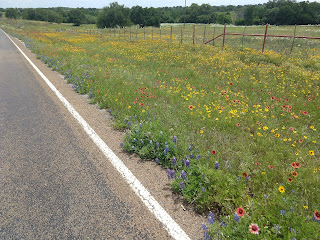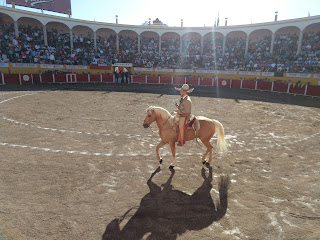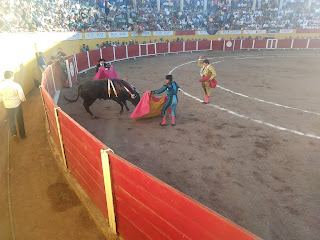Since coming back from Mexico, which seems like eons ago, I've continued my usual busy life of the nomad. Even though the fourth of our five-race series high school races at Dinosaur Valley was cancelled because of a doomsday weather forecast (just a couple of days after my return from Mexico), I've not been sitting around much. While taking care of the weeds (mowing them!), using the Dyson to cleanse the house of all things allergenic, and riding the good old Seven on my daily 35-mile Canyon Lakes route in town I also managed to put the finishing touches on the newest member of my bicycle family: Please welcome the new carbon Ritchey Outback travel bike!
This was a project that had started about half a year ago when I read a shot blip on the South African government's bicycle touring-oriented website and the nutty thought of taking a vacation in the wine regions surrounding the Cape of Good Hope took hold. Alas, the roads out there are not paved--in Argentina, as you know as a faithful reader of this blog, it's called ripio, while here in the US we're now calling it gravel and thus have invented the gravel grinding bikes. Whoohoo. Long live marketing!
Anyhow, since my trusty Ritchey travel bike that accompanies me to so many locales (last stop was New Zealand) is limited to relatively narrow tires (28 mm max) and thus makes riding on non-asphalted surfaces an iffy proposition, I finally pulled the trigger on Ritchey's Outback, a bike that also can be disassembled into an airline-regulation 26" x 26" x 10" case but that features disc brakes and thus can accommodate up to 40 mm tires. Make a long story very short: I'd been sitting with not only the frame but also all of the needed components for almost six month but just could not source the wheelset that I had put my eyes on. It was a bit frustrating, to say the least. But then things finally came together, and in the week before Easter I assembled the new travel machine, went for a shake-down ride in Lubbock, and then put the Outback on the Beemer's One-Up USA rack and drove into the Texas Hill Country to search for Easter eggs. Or new roads.
It was a beautiful trip. Not only did I ride a little more than 175 miles between Thursday and Monday, but I got to see both the in-laws--Mike and Candi, just a tad south of Bertram--and also my friends Micki and Kent in Austin, plus some of their friends and family. On the way down I took the Outback on a loop course around Mullin (about 20 miles south of Brownwood) that was cut short not by the dirt roads but the truly impassable low-water crossing that had been fed by heavy rains the night before. Still, those 12 miles were remote and serene,and then I got to spend 12 enjoyable hours with Judy's family. Nothing like good beer, fine wine, and superb food while being out of earshot of any sounds of civilization outside of soothing background music. Thanks, Mike and Candi!
On Good Friday I left for Austin but soon parked the car somewhere in Cow Creek Canyon and went for a surprisingly tough ten=miler--well, it didn't help that the strong north wind that had gifted me a 39.2 mpg average to that point had not eased up yet, making some of those Hill Country climbs really, really hard. I mean, we're talking granny gears, and I'm using as a low gear a 36/34. No kidding. But talk about scenery and wildflowers. Holy Cow Creek!
Onward I drove, arriving at Micki and Kent's in early afternoon. After stashing my stuff in the guest bedroom and eating some lunch the three of us revved up the bikes and rode west, to two local hot spots, Last Stand Brewery and Jester King Brewing. It was Micki's first road ride in, well, forever, and she showed signs of bum fatigue at the end of this 20-miler on mostly rural roads. While I seemed to recover rather nicely with the help of a wonderful meal and ample libations, she opted to sit out the next day's ride. Kent, of course, was fine, too, and promised me a semi-epic ride on Saturday.
And so we went out, on trails known only to Kent, sidewalks, bike-paths, and little-frequented residential roads, all the way from way out of west of Austin to Zilker Park and downtown, both of which were like a zoo and teeming with people of interesting pedigree. Nothing like people-seeing in Austin .... and don't forget ganja-smelling, too.
We made it through those central parts and hooked up with Walnut Creek trail, a truly amazing 12.5-mile concreted trail that runs generally in a SW to NE direction. The money that must have been spent on this trail for bridges, lighting, and landscaping is mind boggling. Lucky for those who get to use it. And thus we found ourselves in the northeast corner of the greater Austin area and still had to ride back, to the southwest quadrant. I couldn't convince Kent that stopping in a brewpub that I happened to spy on our route would relieve him of all saddle-induced discomfort, and so we slogged on until we came to a full and complete stop in front of a Specs liquor store and Kent solemnly declared that he was done and would call Micki to pick him up. Well, I quickly bought a nice post-ride sixer of IPA, placed it in Kent's hands with the admonishment not to drink it all, and then went out for the last 15 miles or so home. After a total of 58 miles for the day on the new Outback, I felt happy and certainly tuckered but also refreshed after a shower and an IPA or two or whatever it takes to rehydrate.
And that brings us to Sunday, when we rode down to Buda where Micki's parents live. I'll spare you logistic details, because everybody was going to ride (plus a friend, Carol) and there was the need for truck shuttles etc. But eventually we made it down to Jimmy and Gwen's, Micki's sister, Deena, had arrived, and while somebody made a lunch run Jimmy pulled out the e-bikes and also an old recumbent and we took turns trying to kill ourselves. When It came time to head home, Kent claimed to be the victim of mysterious butt calluses that were forcing him to abandon even the thought of bike riding. And so I punched a few coordinates into my Locus mapping app and we agreed to met at 24-Hour Fitness, where Carol and Micki were members who could guest-in people for a soak in the hot tub.... nice. And since a ride is only a ride when you finish it, I rode the remaining five miles home from there. The evening ended in the usual general food and drink debauchery. Thanks, my dear friends, Micki and Kent!
And that leaves us just with the drive home, on Monday. Using Locus once again, I had mapped out a ride around Llano, just about an hour into the almost seven-hour drive home. Oh, what a glorious ride it was. For 33 miles I was surrounded by oceans of wildflowers. I have never seen anything like it. They were all out: bluebonnets, Indian paintbrush, firewheels, Mexican sombreros, whatever they are called. The roads I had chosen were partly gravel, and it all validated the sanity of my building up this new bike. I encountered almost no traffic (maybe 20 vehicle in all those miles) and I felt free to explore and go down roads that I knew were going to lead somewhere but whose condition I knew nothing about.
I made it back to Lubbock ten minutes before the dinner appointment time with my old buddy Barry and his son, Young Master Maximus, who were in from New York and whom I had welcomed to my house on Thursday before Easter. Ten minutes, no shit, to get ready. And we had, as usual, the time of our lives, which lasted until at least midnight. The next day I Ubered for my Lyft friend Beth, who was just coming back from a one-week trip to Prague. And in between all this, I rode my bike, cleaned the house, packed and unpacked and re-packed, and did laundry, of course. And made some serious preparations for some upcoming trips!
But now it is time to have dinner and then get some sleep for tomorrow's race. I love the kids, I love my co-workers, and I love the whole atmosphere of the high school scene. And next week I'm continuing with a UCI race just outside of Park City, Utah. How could life be any better? (Well, I now know: This crap hole motel in which I am stuck tonight could have had internet service fast enough to finish this blog by allowing me to upload the pics. Stay away from the Bastrop Inn!)
Jürgen





























































































































